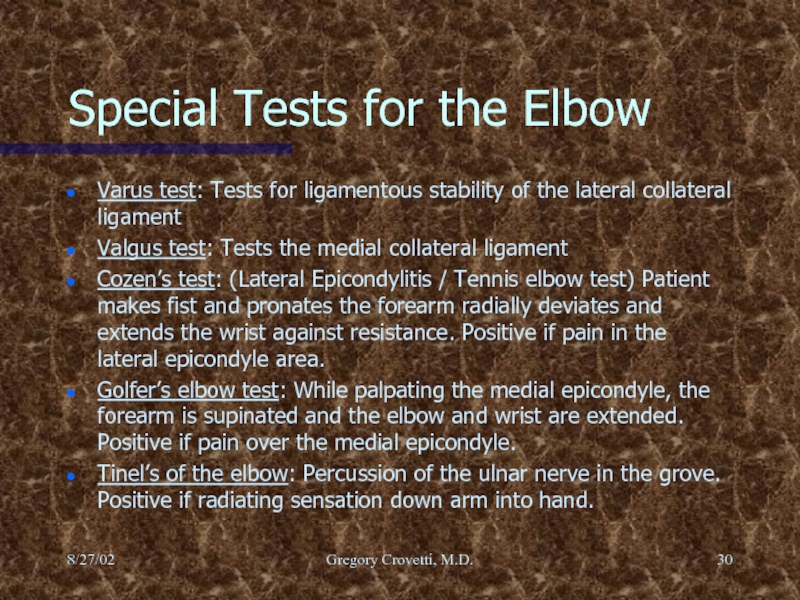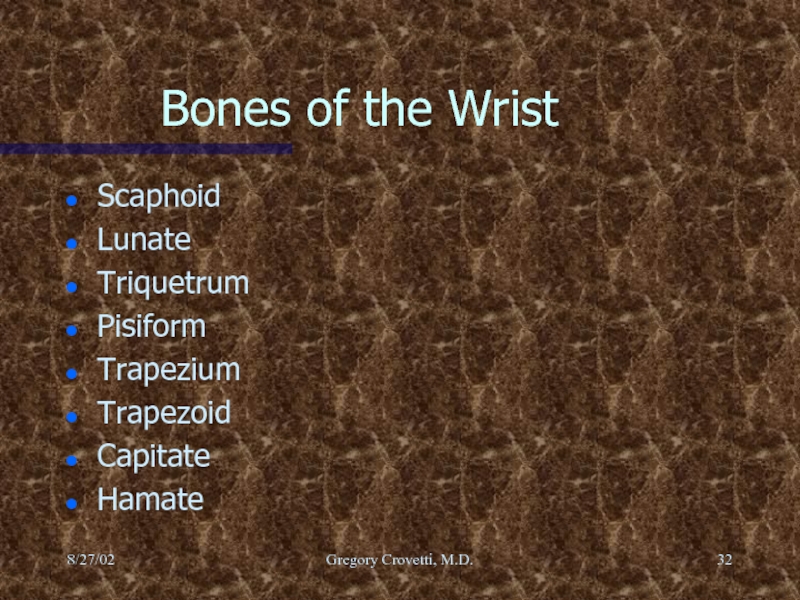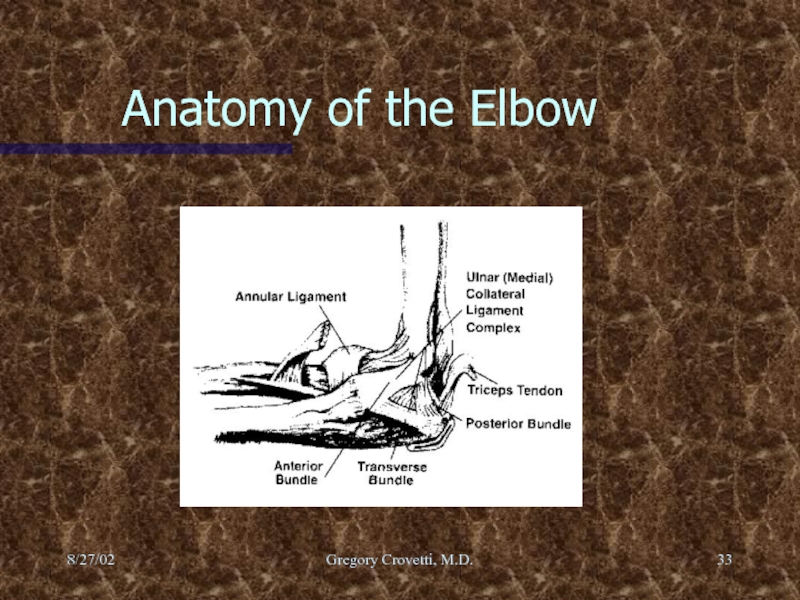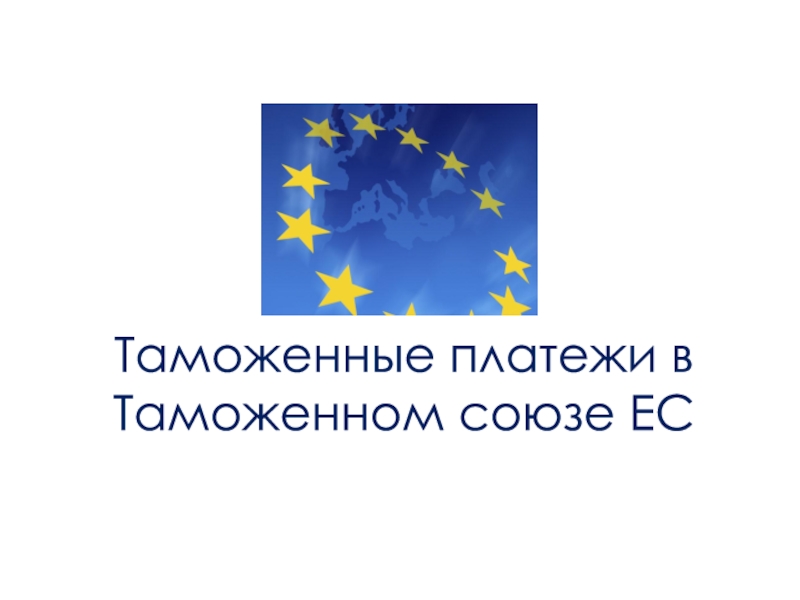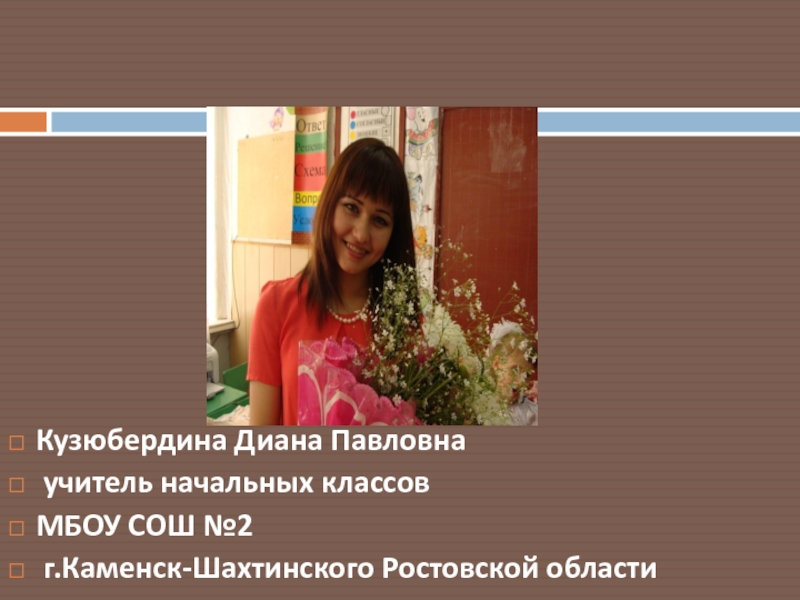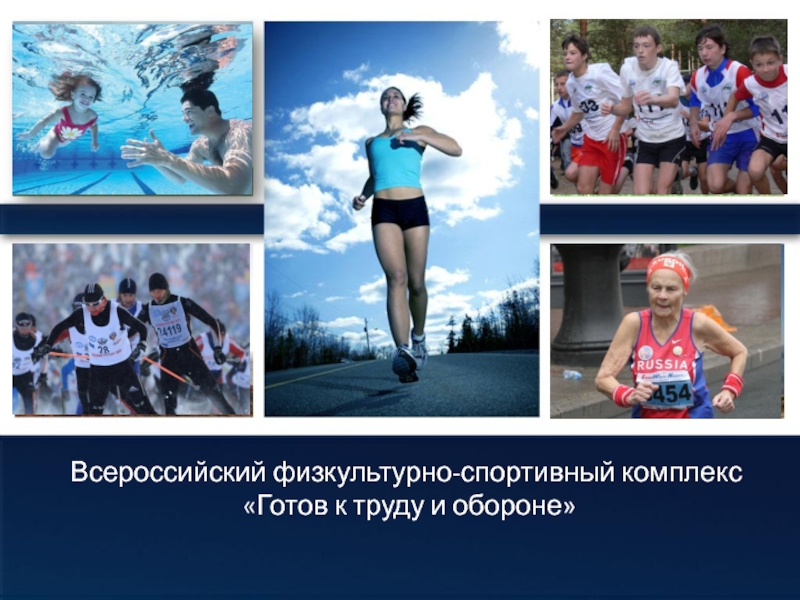Разделы презентаций
- Разное
- Английский язык
- Астрономия
- Алгебра
- Биология
- География
- Геометрия
- Детские презентации
- Информатика
- История
- Литература
- Математика
- Медицина
- Менеджмент
- Музыка
- МХК
- Немецкий язык
- ОБЖ
- Обществознание
- Окружающий мир
- Педагогика
- Русский язык
- Технология
- Физика
- Философия
- Химия
- Шаблоны, картинки для презентаций
- Экология
- Экономика
- Юриспруденция
General Musculoskeletal Screening: Upper Extremities
Содержание
- 1. General Musculoskeletal Screening: Upper Extremities
- 2. 8/27/02Gregory Crovetti, M.D.General ApproachHistoryInspectionRange of Motion (ROM)PalpationMuscular and neurological exams
- 3. 8/27/02Gregory Crovetti, M.D.HistoryAn accurate history is essentialWill
- 4. 8/27/02Gregory Crovetti, M.D.General InspectionObserve how the patient
- 5. 8/27/02Gregory Crovetti, M.D.Inspection of Specific AreaLook for asymmetry between sidesSwelling DeformitiesAtrophyErythema
- 6. 8/27/02Gregory Crovetti, M.D.Range of Motion (Active)Have patient
- 7. 8/27/02Gregory Crovetti, M.D.Range of Motion (Passive)Next range
- 8. 8/27/02Gregory Crovetti, M.D.PalpationWhen palpating a structure, you
- 9. 8/27/02Gregory Crovetti, M.D.Muscular and NeurologicalCheck the following
- 10. 8/27/02Gregory Crovetti, M.D.Generalized Screening ExamIf any abnormalities,
- 11. 8/27/02Gregory Crovetti, M.D.Neck: Active Range of MotionChin
- 12. 8/27/02Gregory Crovetti, M.D.Special Tests for the NeckDekleyn
- 13. 8/27/02Gregory Crovetti, M.D.Shoulder ExamInspectionPalpationPassive Range of MotionActive
- 14. 8/27/02Gregory Crovetti, M.D.The ShoulderJoints of the shoulderGlenohumeralSternoclavicularAcromioclavicularScapular thoracic (not a true joint)
- 15. 8/27/02Gregory Crovetti, M.D.Glenohumeral Joint
- 16. 8/27/02Gregory Crovetti, M.D.Glenohumeral LigamentsFolds in the anterior
- 17. 8/27/02Gregory Crovetti, M.D.Glenoid LabrumGlenoid labrum: a fibrocartilaginous
- 18. 8/27/02Gregory Crovetti, M.D.ScapulothoracicScapular stabilizing muscles:Trapezius (all three portions)Serratus anteriorRhomboidsLevator scapulaePectoralis Minor
- 19. 8/27/02Gregory Crovetti, M.D.Acromioclavicular JointAcromioclavicular ligament: resists axial
- 20. 8/27/02Gregory Crovetti, M.D.Sternoclavicular JointThese structures still allow
- 21. 8/27/02Gregory Crovetti, M.D.ShoulderPalpation of the shoulder includes:
- 22. 8/27/02Gregory Crovetti, M.D.ShoulderRotator cuff:SupraspinatusInfraspinatusTeres MinorSubscapularis
- 23. 8/27/02Gregory Crovetti, M.D.
- 24. 8/27/02Gregory Crovetti, M.D.Special Tests for the ShoulderApprehension
- 25. 8/27/02Gregory Crovetti, M.D.Special Tests for the ShoulderFeagin
- 26. 8/27/02Gregory Crovetti, M.D.Special Tests for the ShoulderYergason’s
- 27. 8/27/02Gregory Crovetti, M.D.Special Tests for the ShoulderImpingement
- 28. 8/27/02Gregory Crovetti, M.D.The ElbowPalpation: lateral and medial
- 29. 8/27/02Gregory Crovetti, M.D.
- 30. 8/27/02Gregory Crovetti, M.D.Special Tests for the ElbowVarus
- 31. 8/27/02Gregory Crovetti, M.D.Wrist and HandInspect for swelling
- 32. 8/27/02Gregory Crovetti, M.D.Bones of the WristScaphoidLunateTriquetrumPisiformTrapeziumTrapezoidCapitateHamate
- 33. 8/27/02Gregory Crovetti, M.D.Anatomy of the Elbow
- 34. 8/27/02Gregory Crovetti, M.D.Nerves of the HandUlnarRadial Median Palmar branch of the median
- 35. 8/27/02Gregory Crovetti, M.D.
- 36. 8/27/02Gregory Crovetti, M.D.
- 37. 8/27/02Gregory Crovetti, M.D.
- 38. 8/27/02Gregory Crovetti, M.D.Special Tests of Hand and
- 39. 8/27/02Gregory Crovetti, M.D.Special Tests of Hand and
- 40. 8/27/02Gregory Crovetti, M.D.Special Tests of Hand and
- 41. 8/27/02Gregory Crovetti, M.D.Special Tests of Hand and
- 42. 8/27/02Gregory Crovetti, M.D.Special Tests of Hand and
- 43. 8/27/02Gregory Crovetti, M.D.Special Tests of Hand and
- 44. 8/27/02Gregory Crovetti, M.D.Case75-year old man comes in
- 45. Скачать презентанцию
8/27/02Gregory Crovetti, M.D.General ApproachHistoryInspectionRange of Motion (ROM)PalpationMuscular and neurological exams
Слайды и текст этой презентации
Слайд 1 General Musculoskeletal Screening: Upper Extremities
Gregory Crovetti, M.D.
Sports Medicine Program
West
Suburban Health Care
Слайд 28/27/02
Gregory Crovetti, M.D.
General Approach
History
Inspection
Range of Motion (ROM)
Palpation
Muscular and neurological exams
Слайд 38/27/02
Gregory Crovetti, M.D.
History
An accurate history is essential
Will give you diagnosis
80-90% of time
How symptoms started (mechanism of injury)?
Duration of complaint?
Location,
nature of pain, or symptoms?Exacerbating or relieving maneuvers?
Слайд 48/27/02
Gregory Crovetti, M.D.
General Inspection
Observe how the patient moves as they
go into the room or move from chair to table
General
appearanceBody proportions
Слайд 58/27/02
Gregory Crovetti, M.D.
Inspection of Specific Area
Look for asymmetry between sides
Swelling
Deformities
Atrophy
Erythema
Слайд 68/27/02
Gregory Crovetti, M.D.
Range of Motion (Active)
Have patient range the joints
Watch
for decreased or increased movement of the joint compared to
the other side as well as the normWatch for pain with movement
Listen for crepitus or “popping”
Watch for abnormal movements
Слайд 78/27/02
Gregory Crovetti, M.D.
Range of Motion (Passive)
Next range the joints passively,
comparing the end points to the active
Again note any decreased
or increased movementPain with the movement
Crepitus or “popping”
Слайд 88/27/02
Gregory Crovetti, M.D.
Palpation
When palpating a structure, you need to know
the anatomy of that structure
Palpate for swelling
Palpate for warmth
Palpate each
area of the structure in turn evaluating for pain, and abnormalities as compared to the other sideСлайд 98/27/02
Gregory Crovetti, M.D.
Muscular and Neurological
Check the following comparing one side
to the other:
Grade strength (0-5)
Grade reflexes (0-4)
Sensory exam
Слайд 108/27/02
Gregory Crovetti, M.D.
Generalized Screening Exam
If any abnormalities, a more thorough
exam of the joint needs to be done.
Each joint
is:Inspected (look for abnormalities)
Palpated
Examined
Слайд 118/27/02
Gregory Crovetti, M.D.
Neck: Active Range of Motion
Chin to chest (flexion)
“look
at ceiling” (extension)
Chin to each shoulder (lateral rotation)
Ear to each
shoulder (lateral flexion, i.e., head tilt)Слайд 128/27/02
Gregory Crovetti, M.D.
Special Tests for the Neck
Dekleyn test: head and
neck rotation with extension. Tests for vertebral artery compression.
Spurlin’s: (foraminal
compression test): patient extends rotates head to side, the examiner then applies axial load to the head. Positive test is when there is pain radiating into arm. Indicates Pressure on a nerve root. Elvey test: (upper limb tension tests): tests designed to put stress on the neurological structures of the upper limb.
Median nerve C5,6,7
Median nerve, axillary nerve
Radial nerve
Ulnar nerve C8, T1
Слайд 138/27/02
Gregory Crovetti, M.D.
Shoulder Exam
Inspection
Palpation
Passive Range of Motion
Active Range of Motion
Appley
scratch test for internal/external rotation
Impingement Signs
Bicep Tendonitis/Crossarm adduction/apprehension
Neck exam: compression
testAdson’s manuever
Слайд 148/27/02
Gregory Crovetti, M.D.
The Shoulder
Joints of the shoulder
Glenohumeral
Sternoclavicular
Acromioclavicular
Scapular thoracic (not a
true joint)
Слайд 168/27/02
Gregory Crovetti, M.D.
Glenohumeral Ligaments
Folds in the anterior capsule produce the
superior, middle and inferior glenohumeral ligaments.
Like the capsule these
ligaments come into play based upon arm position and rotation. Слайд 178/27/02
Gregory Crovetti, M.D.
Glenoid Labrum
Glenoid labrum: a fibrocartilaginous rim to increase
the contact area and depth of the glenoid
Triangular on cross-section
and three sides which face the humeral head, joint capsule, and glenoid surface respectivelyAn intact labrum increases humeral contact area by 75% in vertical and 56% in transverse directions
Слайд 188/27/02
Gregory Crovetti, M.D.
Scapulothoracic
Scapular stabilizing muscles:
Trapezius (all three portions)
Serratus anterior
Rhomboids
Levator scapulae
Pectoralis
Minor
Слайд 198/27/02
Gregory Crovetti, M.D.
Acromioclavicular Joint
Acromioclavicular ligament: resists axial rotation and posterior
translation
Trapezoid: is anterolateral, resists axial compression of the distal end
of the clavicleConoid: is posteromedial, resists anterior and superior translation
Слайд 208/27/02
Gregory Crovetti, M.D.
Sternoclavicular Joint
These structures still allow for 35 degrees
of elevation, 35 degrees of translation, and 50 degrees of
rotation at the sternoclavicular jointСлайд 218/27/02
Gregory Crovetti, M.D.
Shoulder
Palpation of the shoulder includes:
Sternoclavicular joint
Acromioclavicular joint
Subacromial
area
Bicipital groove
Muscles of the Scapula
Have patient place each hand:
Behind head
(external rotation and abduction)Up the small of the back (internal rotation)
Слайд 228/27/02
Gregory Crovetti, M.D.
Shoulder
Rotator cuff:
Supraspinatus
Infraspinatus
Teres Minor
Subscapularis
Слайд 248/27/02
Gregory Crovetti, M.D.
Special Tests for the Shoulder
Apprehension (crank) test: The
arm is abducted to 90 degrees and laterally rotated. Positive
test is when the patient has feeling as if the shoulder may “come out.”Jobe relocation test: A posterior stress placed to the shoulder in the above position will cause relief of pain and apprehension if positive.
Rockwood test for anterior instability: Similar positioning as the crank test, but the shoulder is laterally rotated at 0, 45, 90, and 120 degrees.
Rowe test for anterior instability: Patient supine with hand behind head. Examiners clenched fist placed behind the humeral head and a downward force is applied to the arm.
Fulcrum test: Patient supine arm abducted to 90 degrees, examiners hand under the glenoid and the arm is laterally rotated.
Anterior and posterior drawer: 0-25% translation (normal), 25-50% (Grade I), >50% but spontaneously reduces (Grade II), >50% remains dislocated (Grade III)
Слайд 258/27/02
Gregory Crovetti, M.D.
Special Tests for the Shoulder
Feagin test: arm abducted
to 90 elbow straight arm on examiner’s shoulder, a don
and forward pressure is applied. Positive if apprehension and presence of anteroinferior instability.Clunk test: Patient supine, examiner hand on the posterior aspect of the shoulder, other hand hold the humerus above the elbow and abducts the arm over the head. Then pushing anteriorly with the hand under the shoulder and rotating the humerus laterally with the other hand, feel for a grind or clunk which may indicate a tear of the labrum.
Compression rotation test: Patient supine, elbow flexed and abducted 20 degrees, the examiner pushes up on the elbow and rotates the humerus medially and laterally. Snapping or catching is positive for labral tear.
Scapular thoracic glide tests: To determine the stability of the scapula during glenohumeral movements.
Speed’s test: forearm supinated, elbow extended and resistance to forward flexion of the shoulder. Positive if tenderness in the bicipital groove indicating bicipital tendinitis.
Слайд 268/27/02
Gregory Crovetti, M.D.
Special Tests for the Shoulder
Yergason’s test: Elbow flexed
to 90 degrees, forearm pronated, resistance to supination is applied
as the patient also laterally rotates the arm. Positive if pain in the bicipital groove and indicates bicipital tendinitis.Supraspinatus (empty can/ Jobes) test: The shoulder is forward flexed at 30 degrees, arms straight and thumbs pointing to ground, a downward force is applied to the arms. Tests for tear or weakness of the supraspinatus.
Codman’s (drop arm) test: shoulder is abducted to 90 degrees and patient asked to lower the arm slowly. If drops or is painful, it is positive and indicates tear in the rotator cuff.
Neer impingement test: Arm is elevated through forward flexion, positive if painful.
Hawkins-Kennedy impingement test: Arm is forward flexed to 90 then internally rotated, positive if painful.
Слайд 278/27/02
Gregory Crovetti, M.D.
Special Tests for the Shoulder
Impingement test: Arm is
abducted to 90 and full lateral rotation, positive if painful.
Military
brace (Costoclavicular Syndrome) test: Palpate the radial pulse as the shoulder is drawn down and back. Positive if a decreased pulse and indicates possible thoracic outlet syndrome.Adson Maneuver: radial pulse palpated as arm is rotated laterally and elbow is extended as the patient extends and rotates head to test shoulder.
Allen test: Elbow is flexed to 90, shoulder abducted and laterally rotated and patient rotates head away for the test side.
Halstead maneuver: Radial pulse felt as arm is pulled down as the patients neck is hyperextended and rotated to the opposite side.
Слайд 288/27/02
Gregory Crovetti, M.D.
The Elbow
Palpation: lateral and medial epicondyles, olecranon, radial
head, groove on either side of the olecranon
Inspect the carrying
angle, and any nodules or swelling Слайд 308/27/02
Gregory Crovetti, M.D.
Special Tests for the Elbow
Varus test: Tests for
ligamentous stability of the lateral collateral ligament
Valgus test: Tests the
medial collateral ligamentCozen’s test: (Lateral Epicondylitis / Tennis elbow test) Patient makes fist and pronates the forearm radially deviates and extends the wrist against resistance. Positive if pain in the lateral epicondyle area.
Golfer’s elbow test: While palpating the medial epicondyle, the forearm is supinated and the elbow and wrist are extended. Positive if pain over the medial epicondyle.
Tinel’s of the elbow: Percussion of the ulnar nerve in the grove. Positive if radiating sensation down arm into hand.
Слайд 318/27/02
Gregory Crovetti, M.D.
Wrist and Hand
Inspect for swelling or deformities
Palpate: anatomic
snuff box, volar and dorsal aspects of the wrist, all
joints of the fingersFlexion, extension, ulnar and radial deviation of the wrist
Have patient make a fist and extend and spread the fingers.
Слайд 328/27/02
Gregory Crovetti, M.D.
Bones of the Wrist
Scaphoid
Lunate
Triquetrum
Pisiform
Trapezium
Trapezoid
Capitate
Hamate
Слайд 348/27/02
Gregory Crovetti, M.D.
Nerves of the Hand
Ulnar
Radial
Median
Palmar branch of the
median
Слайд 388/27/02
Gregory Crovetti, M.D.
Special Tests of Hand and Wrist
Cascade sign: Patient
flexes the fingers, the tips should all converge toward the
scaphoid tubercle. If they do not, it may indicate a fracture in that finger.Boutonniere deformity: Extension of the MCP and DIP joints and flexion of the PIP joint. This is due to a rupture of the central tendinous slip of the extensor hood.
Swan-neck deformity: Flexion of the MCP and DIP joints, with extension of the PIP joint. This is due to contracture of the intrinsic muscles. Seen after trauma or in RA.
Ulnar drift: Ulnar deviation of the digits most commonly due to RA.
Dupuytren’s contracture: This is due to contracture of the palmar fascia. Most common in the ring finger or little finger, men more then women, ages 50-70.
Claw fingers: This deformity is a form a combination of a ulnar and median nerve palsy. This causes loss of intrinsic muscle function and over action of the extrinsic extensors. This causes hyperextension of the MCP joints and flexion of the PIP and DIP joints. If the intrinsic function of the hand is lost, it is then called an intrinsic minus hand.
Слайд 398/27/02
Gregory Crovetti, M.D.
Special Tests of Hand and Wrist
Trigger finger: Results
from a thickening of the flexor tendon sheath, causing sticking
of the tendon. At later stages the finger can become stuck in flexion, needing to be passively extended. Associated with RA.Bishop’s Hand: (Benediction Hand) Secondary to ulnar nerve palsy. There is wasting of the hypothenar, interossei, and the two medial lumbrical muscles. Flexion of the 4th and 5th fingers is the most noticeable deformity.
“Z” deformity of the thumb: May be secondary to RA or heredity. The thumb is flexed at the MCP and hyperextended at the IP joint.
Drop- wrist: Secondary to radial nerve palsy.
Mallet finger: The distal phalanx remains in flexion when the finger is extended. This is the result of rupture or avulsion of the extensor tendon from the distal phalanx.
Clubbing: Can be caused by many medical problems such as pulmonary or cardiac diseases, as well as genetic.
Heberden’s nodes: Swelling of the DIP joints secondary to OA.
Bouchard’s nodes: Swelling of the PIP joints secondary to RA.
Слайд 408/27/02
Gregory Crovetti, M.D.
Special Tests of Hand and Wrist
Ganglion cyst: Localized
swelling usually on the dorsum of the hand.
Thumb ulnar collateral
ligament test: (test for gamekeeper’s or skier’s thumb) Valgus stress applied to the MCP joint, if 10-20 degrees there is most likely a partial tearCarpal Compression test: Pressure applied directly to the carpal tunnel for 30 seconds. If positive, indicates carpal tunnel syndrome.
Froment’s sign: Patient holds piece of paper between the thumb and index paper. If the distal phalanx flexes, it is a positive test and indicates ulnar nerve palsy. If the MCP joint hyperextends, it is a positive Jeanne’s sign and also indicates ulnar nerve palsy.
Allen test: Tests for competency of the ulnar and radial arteries.
Anatomic snuffbox: Lies between the extensor pollicis longus and extensor pollicis brevis tendons. The scaphoid bone is palpated inside the box as well as the radial styloid. Pain in the box should indicate scaphoid fracture until proven otherwise.
Слайд 418/27/02
Gregory Crovetti, M.D.
Special Tests of Hand and Wrist
Guyon’s canal: (pisohamate)
Through this canal runs the ulnar nerve. If compression of
the canal occurs, there is sensation lose to the fingers and muscle weakness in the hand of ulnar distribution.>35 degrees indicates a torn ulnar and accessory collateral ligaments.
Murphy’s sign: Patient makes a fist, if the head of the third metacarpal is level with the second and fourth metacarpals, it is a sign of a lunate dislocation.
Retinacular ligament test: Test for the structures around the PIP joint. The patient is passive, the PIP joint is held in extension and the DIP is flexed. If the DIP does not flex, the retinacular ligaments (collateral) or capsule is tight. The PIP joint is the flexed, if the DIP now flexes easily, the retinacular ligaments are tight and the capsule is normal.
Lunatotiquetral Ballottement (Reagan’s test): The triquetrum is grasped between the thumb and second finger of one hand and the lunate between the thumb and second finger of the other hand. The lunate is then moved up and down, if any laxity, crepitus or pain it indicates a positive test for Lunatotriquetral instability.
Слайд 428/27/02
Gregory Crovetti, M.D.
Special Tests of Hand and Wrist
Watson (scaphoid shift)
test: The patient’s hand is taken into full ulnar deviation
and slight extension. With the other hand the thumb is pressed against the distal pole of the scaphoid to prevent it from moving. The patient’s hand is then moved radially and slightly flexed. If the dorsal pole of the scaphoid subluxes over the dorsal rim of the radius and there is pain, it is a positive test for scaphoid and lunate instability.Scaphoid stress test: Modification of Watson test in which the patient actively radial deviates the wrist while scaphoid pressure is applied. If there is pain and a clunk, it is a positive test.
“Piano Key” test: Patient’s arms are in pronation. Using the index finger while stabilizing the hand with the other hand the distal ulna is pushed down. The test is positive if there is pain and difference in mobility compared to the other side. This indicates distal radioulnar joint instability.
Axial load test: Axial load to the thumb or fingers, if pain or crepitation it is a positive test for metacarpal or adjacent carpal bone fracture or joint arthrosis.
Grind test: Grabbing the thumb below the metacarpophalangeal joint, an axial load is applied with rotation. If there is pain the test is positive and indicates DJG of the metacarpophalangeal or metacarpotrapezial joints.
Слайд 438/27/02
Gregory Crovetti, M.D.
Special Tests of Hand and Wrist
Finkelstein test: Tests
for De Quervain’s or Hoffmann’s disease. A positive test indicates
a tenosynovitis of the abductor pollicis longus and extensor pollicis brevis tendons.Sweater finger sign: When patient makes a fist, if one of the distal phalanx (most often the ring finger) does not flex, the test is positive. It indicates a ruptured flexor digitorum profundus tendon.
Bunnel-Littler test: (Finochietto-Bunnel test) The patient is passive during the test. The test is for structures around the MCP joint. The MCP joint is held in extension, while the PIP is flexed. If unable to flex the PIP, the test is positive and indicates tight intrinsic muscle or contracture of the joint capsule. The MCP is then slightly flexed, if the PIP now flexes easily it indicates tight intrinsic muscles and that the capsule is normal. If the PIP still does not flex it indicates a tight joint capsule.
Tinel’s sign: Positive if tingling into the fingers of the median nerve distribution, indicating carpal tunnel syndrome.
Phalen’s test: Position must be held for one minute. If positive indicates carpal tunnel syndrome. The dorsal aspect of the hands is pushed together to maximal flexion of the wrists.
Слайд 448/27/02
Gregory Crovetti, M.D.
Case
75-year old man comes in for yearly physical.
History
of hypertension, elevated lipids, and mild obesity
He has taken your
advise and started an exercise program, and now has a complaint of right shoulder pain. What do you want to know?
What do you do next?





























